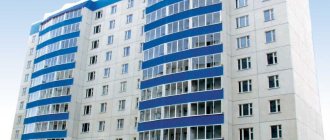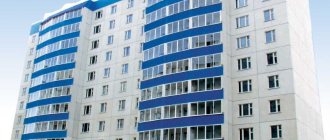When constructing each building, not only the estimate is calculated, but also its operating time, in other words, wear and tear. This factor determines the service life of the brick. The degree of service life of each building is different and there is no average for everyone, this is a conditional measure. If the service life has expired, this does not mean that the building is not suitable for further use. The fact is that after this period the building loses some of its useful qualities, and with the use of some restoration operations it can remain standing for a long time.
What is the service life of a brick house
Brick is rightfully considered one of the most popular materials for the construction of residential buildings and buildings for other purposes.
Any structure erected from it can last 150 years or more, only occasionally needing repairs.
But the service life of an apartment brick building depends not only on the quality of the building stone itself. In addition, it is influenced by other factors.
Brick masonry technology
What determines the lifespan of brick buildings?
Over time, absolutely any construction projects become unusable. Buildings made of brick are no exception. The main factors influencing the period of their use are:
- the quality of materials used in the process of building a house. These include not only brick, but also components of individual structural elements - the foundation of the building, floor, roofing, utilities. If, for example, a house uses wooden floors, it will last much less, which is why these structures are made mainly of concrete;
- population density of a multi-storey building, load;
- compliance with the requirements for the operation of the house and the regularity of major repairs, timely elimination of any emergency situations;
- design solutions used in the process of building a house;
- construction technologies.
Physical and moral deterioration of buildings
To calculate the service life of a finished house, its wear and tear is first calculated, which can be of two types:
- moral. It represents the compliance of the technologies, materials and structural elements used in construction with their functional purpose and existing requirements;
- physical. is calculated using specially developed tables and is the ratio of the specific weight of wear to the cost of certain components and materials.
Depreciation is calculated not for the entire multi-apartment building, but for its individual elements - the roof structure and foundation, stairs and floors, walls and internal partitions, utilities and others.
If we are talking about a brick house, then the type of building stone is of great importance. For example, ceramic brick can last the longest. Silicate and concrete materials have a significantly shorter service life.
It is also important to take into account the following factors during the calculation process:
- compliance of the building foundation with the expected loads, the quality of its construction;
- the level of groundwater, which over time can negatively affect the condition of the structure, the presence of an effective drainage system for its disposal;
- the presence of waterproofing of the foundation and walls, which significantly extends the service life of the structure.
How long can an apartment building last?
In many cities of our country, buildings from the 60s, built of brick, are successfully used. However, not all of them have undergone major repairs. Many experts say that Khrushchev buildings are quite capable of serving for more than 100 years.
What is the service life of buildings built using modern technologies? If we turn to the opinions of experts, we get the following data:
- panel houses, which today belong to the economy class, have every chance of “surviving” for 30-40 years before major repairs. Such a short period is due to the need to monitor the condition of the interpanel seams, which collapse much earlier than the panels themselves. If you comply with all maintenance requirements for such a structure, it will successfully last 50-75 years;
- The longest service life is for monolithic buildings belonging to the business or elite categories. It is 150 years old, as high-quality materials are used in the construction process. In addition, such houses are equipped with modern utilities that can serve for many years without repair;
- brick houses that use ceramic building stone last about 100 years. But in about half a century they will need major repairs.
If we talk exclusively about brick, then the materials from which it is made are of great importance. As an example, we can provide the following information:
- houses made of double silicate bricks marked M-150 (resistance to loads of 150 kilograms per square centimeter) will definitely last more than 50 years. Therefore, this material is used for the construction of capital walls, ensuring their durability;
- ceramic bricks made using special firing technology are the most durable - buildings made from them are designed for 100-150 years of service;
- clay brick (adobe) is significantly inferior to other types in terms of strength and resistance to stress. Therefore, experts say that it can serve no more than 45-50 years. And this is subject to timely major repairs.
To summarize, we can say that the service life of a brick house depends on a number of factors. These include not only the quality of the material and the construction technologies used.
In addition, the location of the building and any climatic features of a particular region are of great importance.
That is why it is better to trust all calculations and forecasts of the feasibility of building houses with 5, 9 or more floors to specialists who can take into account every small detail.
Types of reinforcement
Depending on the types of loads and the area of masonry that needs reinforcement, the following types of reinforcement are used:
- transverse;
- longitudinal;
- vertical.
Transverse reinforcement is performed using a mesh placed between every 2-5 rows. You can take a ready-made mesh or tie it from reinforcement using wire. It is not advisable to use welding: corrosion may form at the joints. Rods from 5 to 8 mm are suitable; thicker ones negatively affect the strength of the structure. You can also use a zigzag masonry mesh. In this case, it should be laid in adjacent rows, with the rods running perpendicular to each other. Rows are counted from rods pointing in one direction.
It is important to control that the ends of the rods protrude 3-5 mm behind the wall. This way you can track where exactly the reinforcement is located in the wall. Reinforcement is carried out using a solution of at least grade 50; it should cover the reinforcing mesh on all sides by at least 2 mm. This layer will help protect the metal from contact with the external environment and prevent corrosion. Transverse reinforcement is most often used when designing arched openings and other elements of complex configuration.
Lifespan of a brick house – We work with Brick
The service life of a building is a certain period of time during which it is advisable, as well as economically profitable, to use any structure.
This period of time depends on many factors, such as the quality of materials used in construction, capital of the building and many others. The time frame can vary significantly from several years to decades.
Dear reader! Our articles talk about typical ways to resolve legal issues, but each case is unique.
If you want to find out how to solve your particular problem, please use the online consultant form on the right or call.
It's fast and!
The service life of residential buildings classified as buildings of the following main types:
- Houses called Stalinist, which were built in the pre-war period, have a service life of about 130 years.
- Stalin-type houses built after 1945 are about 150 years old.
- Houses that were built en masse, called panel “Khrushchev” buildings, last a maximum of 50 years, however, the state is currently developing a program for the reconstruction of these buildings.
- Houses built of brick in the 60s, which are predominantly five-story, are 100 years old.
- Houses built in the 1970s, both panel and block - 100 years.
- Modern buildings that are panel and have a different number of floors – 100 years.
- Modern houses, which are luxury buildings, are built of brick - thanks to the technologies used in their construction, the service life of these buildings is about 150 years.
Standards depending on construction materials
Depending on the quality and type of materials used in the construction of buildings, their service life is calculated:
- Buildings made using frame technology, as well as those built in bulk, can last about 30 years with proper maintenance.
- Houses in the construction of which such materials as logs and timber were used can be used for about 50 years.
- Buildings, called panel buildings, equipped with reinforced concrete floors, are designed for a service life of about 80 years.
- Buildings made of brick, the so-called light category - 100 years.
- Houses whose walls are 2.5 bricks thick can be used for more than 120 years.
The most durable buildings are those whose walls are 3-3.5 bricks thick, built using stone and brick masonry.
durability of houses
Buildings of different types can be divided into the following categories according to their strength and expected service life:
- Particularly capital ones - their service life is more than 150 years, the buildings are built using materials such as stone and brick.
- Capital - the service life of these houses is equal to one century, the same materials are used in their construction as in the construction of capital ones, however, their walls are somewhat thinner.
- Ordinary - houses of mass construction, their walls are the average size accepted by the standards, can last about 120 years.
- Lightweight stone - houses in this category are built using lightweight, that is, hollow bricks, and have a service life of no more than 120 years.
- Wooden - with proper care and reconstruction, such houses can last for about a century.
Building types
Depending on the materials and technologies used in construction, houses have different categories and types.
The main ones include the following:
- Capital - buildings of this category are among the most durable due to the fact that during their construction the materials of the highest degree of strength are used, such as brick, concrete and stone; In addition to the materials, the long service life of these buildings is due to the fact that the walls of such houses exceed a thickness of 2.5 bricks.
- Particularly capital - especially capital buildings include those buildings whose walls are at least 3 bricks thick, they are the most durable and have the longest service life - more than 150 years; however, this period can be significantly increased when reconstruction work is applied.
These buildings are built primarily of brick and stone; this type of residential structure belongs to the elite category and has a very high cost.
Assessment of the condition of the building depending on wear and tear
Over time, buildings put into operation are assigned a certain rating, which objectively assesses their condition depending on the percentage of physical deterioration.
Buildings are classified according to the following generally accepted criteria:
- A building is rated “good condition” if the wear and tear process is no more than 10%.
- The structure is considered completely satisfactory if the wear is no more than 20%.
- A building is satisfactory if its wear and tear does not exceed 30%.
- The condition of a building is assigned to a less than satisfactory condition when the wear and tear is 40%.
- An unsatisfactory rating is given if there is wear of no more than 60%.
- Housing is considered dilapidated and unfit for habitation in cases where the percentage of wear and tear is 60-75% or more.
Postings
Copper wiring can last for about 40 years. However, after this period of time it must be replaced.
Depending on what materials were used in the manufacture of electrical wiring, its service life directly depends.
For example, aluminum wiring should be used for no more than 20 years , after which it should be replaced.
However, despite these restrictions, the wiring in some homes may not be changed for several decades.
So, for example, in some Stalin-type houses dating back to the pre-war period, external wiring that was put into operation during the same period when the house was commissioned is still functioning.
Pipes
But as you know, in old-style houses, for example, the so-called Khrushchev-era buildings, repair work on the reconstruction of buildings has not been carried out for decades.
According to accepted standards, the service life of pipes related to both the plumbing system and the heating system is about 30 years , depending on the materials used in their manufacture, as well as their functional purpose.
For example, the service life of pipes classified as hot water supply should not exceed 10 years . This period also applies to heating pipes.
It is such a short period of time due to the fact that exposure to hot water, as well as temperature changes, leads to fairly rapid destruction of metal alloys and cast iron, from which these systems are mainly made.
As for the pipes of the cold water supply system, it should not exceed 3 decades , after which a mandatory replacement of these communications must be carried out.
Commissioning period for a residential building
The term for putting a particular residential building into operation means a fixed period of time, which is determined directly by the developer. After completion of construction work, the company that carried it out needs to obtain various types of documents confirming that the house or other facility is ready for operation.
After receiving these documents, the procedure for putting the house into operation is carried out, that is, the apartments are sold and residents move into them.
Punishment for violation
If the developer committed certain violations regarding any building codes, as well as the timing of putting the building into operation, he faces administrative punishment in the form of a fine.
However, in addition to this penalty, residents of the building, or owners of apartments that were purchased but not yet occupied, have the right to apply to the judicial authorities with a claim for the recovery of a penalty in a certain amount due to the developer’s violation of the deadlines for putting the building into operation.
It's fast and!
Protection of consumer rights during the construction of frame houses
Frame construction technology allows you to build houses quickly and relatively cheaply, however, if you deviate from current standards (GOSTs, SNIPs, etc.), the erected structure may turn out to be problematic in terms of the comfort of living in it. In such situations, it is important to correctly use the possibilities of Russian legislation to protect your interests.
Find out right now what methods of protecting consumer rights when performing a construction contract are provided for by law by taking advantage of a free online consultation:
Typical problems of frame houses
Among the possible problems when building a house using frame technology, a number of the most common ones can be identified:
low-quality raw materials (for example, “frozen” board)
up to 30% reduction in frame strength in the first 5–7 years of operation, problems with interior finishing
chipping of fibers, loss of frame rigidity
reduction in the number of metal fasteners
reduction in the durability of the structure
possible head separation
savings on hidden work (for example, drywall on studs)
appearance of cracks in the hydraulic structure, loss of strength
It is important to know: any deviation from the requirements of GOSTs and SNiPs is interpreted by law as a defect and can be appealed in the prescribed manner.
Legal provisions
The customer of construction services and the buyer of real estate are protected by Federal Law No. 2300-1 “On the Protection of Consumer Rights” (dated February 7, 1992); the following are subject to appeal:
- low quality of goods sold/work performed;
- violation of deadlines for performing work on contractual terms;
- violation of deadlines for eliminating identified defects.
It should, however, be noted that the law applies only to cases of legal cooperation on the basis of a legally valid contract (for construction contracts - only in cooperation with a licensed contractor).
Where to go when identifying defects in a frame house
Having identified a defect in the purchased/built house, the consumer has the right to demand:
- free elimination of deficiencies;
- proportional price reduction;
- reimbursement of expenses incurred by him to eliminate deficiencies on his own or with the involvement of third parties.
Service life of a brick house with 5 or 9 floors: duration
What is the lifespan of different types of houses: 50 years, 75, 100, 150, 200 or more?
It all depends on the material (aerated concrete, timber, frame, monolith), operating characteristics, weather and climatic conditions.
In connection with renovations/overhauls, people are increasingly thinking: “Is buying real estate in an old house worth it? Or is it better to buy a new building on the outskirts for the same money?”
Old housing stock means problems with communications, roof leaks, seams coming apart, and freezing. It is quite possible that in a couple of years some kind of renovation program will lead to the demolition of buildings, and high-rise buildings will appear on the site.
Types and service life of a brick house
There are moral and physical. Physical wear and tear refers to the deterioration of buildings as a result of exposure to environmental factors such as rain, high temperature, wind, and sound waves. Moral is understood as the inconsistency of the building with modern requirements, for example, shortcomings in the engineering plan, design flaws.
The timing of wear is largely determined by the building material, type of foundation, and floors of the house. For example, with wooden floors, a building can last no more than 20 years, and with tin and metal floors - more than 100. This factor is also influenced by the type of construction. It follows from this that by 2021, most Khrushchev buildings will no longer be suitable for habitation.
How to evaluate wear?
The assessment is carried out based on a set of indicators, in percentage terms and reflects its degree.
For example, buildings with a wear level of 10% and below are considered good, but if this level is 80%, then living in such a building is unacceptable.
Wear is determined to a large extent visually and using some tests. During the evaluation process, relative data on further use time is provided.
This is important to know: Responsibilities of the HOA manager in apartment buildings
How to increase the service life of a building?
The main way to increase the time of use of a building is to initially build it “conscientiously.” Correct design of the foundation, type of floor, its quality and materials that were used during construction.
Therefore, it is so important to take into account all the nuances of construction, so that the issue of extending this period is postponed until the 10th anniversary, or even the 100th anniversary. Basically, to increase operational characteristics, it is worthwhile to restore the foundation, replace outdated wiring and water pipes, and install additional supports (if necessary).
These operations are enough for a cottage, house or high-rise building to continue to exist for at least another 10-15 years.
Service life of a brick apartment building
Standard service life of residential high-rise buildings. Houses of different types have different service life, ranging from 50 years to 150. Let’s see which houses “live” for how long.
- Panel “Khrushchev” buildings built in the 50s–70s of the 20th century are of much worse quality and are designed to last only 50 years. According to all standards, they should be demolished between 2005 and 2020. They are not subject to reconstruction.
- Brick five-story buildings of the same construction period have a service and maintenance repairs of the housing stock are planned for 2015–2030 .
- Panel and block high-rise buildings of 9–16 floors, built before 1980, last 100 years without reconstruction and should be demolished in 2055–2080.
- More modern panel houses built before 1998 are also not subject to reconstruction, and will be dismantled in 2070–2105.
Operation of housing stock for which major repairs have come due.
If the life of the house is approaching the time of major repairs (or reconstruction, which is more correct, since the wear and tear of buildings by that time is very high), then the management organization begins the repair process. This event lasts a long time, taking from six months to three years (in some cases).
The degree of physical deterioration of the building is preliminarily assessed in order to decide to what extent to carry out repairs. The condition of a residential building is considered satisfactory if by the time of major repairs the physical wear and tear is no more than 30%. If the percentage is higher, then they say that the condition of the house is not entirely satisfactory, unsatisfactory and dilapidated.
A house is considered uninhabitable (unsafe) only if there is 75% physical wear and tear and there is a threat of collapse. Then a decision is made to resettle the residents and demolish the house. This decision is made on the basis of an application from the homeowner or the organization responsible for the material and technical condition of the house.
If the commission decides that the housing is safe for life, resettlement may not take place even if there is great physical wear and tear, although the housing will be classified as dilapidated. In this case, a decision may be made to reconstruct the house.
Resettlement of an emergency house
Residents of emergency houses that are subject to resettlement are assigned to live in newly built houses that have been put into operation under the state program. Putting a residential building into operation is a long process that takes from three months to a year. Therefore, even if a new house has already been built, it is quite possible that relocation may not occur immediately.
It should also be taken into account that the Moscow program for relocation from dilapidated housing does not cover all houses for which restoration/demolition has come due, so the process of relocation to new housing may take several years.
According to the amendment introduced to the Housing Code, the resettlement of city residents from emergency housing can also be carried out to houses outside the city, since the resettlement program does not fall into the category of improving living conditions, but is a forced measure to provide housing.
In addition, the number of rooms may not coincide, since the main guideline in this matter is the area of the room, not residential, but general.
Thus, it is impossible to predict the quality of new housing, whether it will improve or worsen - everything depends on the availability of available housing stock.
This is important to know: Rights and responsibilities of the chairman of a condominium association of an apartment building
If the quality of housing is not satisfactory
If the quality or location of the housing provided does not satisfy the apartment owners, then they may be paid the cost of the old apartment plus the costs of moving, independently searching for housing and paperwork. If the amount is not satisfactory, then an appeal should be made to the court, where the plaintiff is the body responsible for resettlement. The court decides how much to pay the intractable owner.
Managing partner of Gravion Group Yuri Nemanezhin answers:
The service life of modern houses, regardless of their construction technology, that is, whether it is a monolith, brick or panel, is about 100 years.
However, here it is necessary to understand that everything depends on what material is used during construction, and how well the builders themselves work, since another monolithic house may crack already at the commissioning stage.
For example, there was a case when a construction organization poured a foundation in unfavorable weather conditions without complying with technical standards. Later during construction, the foundation of the house burst, and the developer had to stop construction and urgently take measures to eliminate the consequences.
As for panel houses, today the quality of the modules produced is quite high and meets all existing requirements. The only question is that the seams between the panels are carefully sealed with high-quality materials. Also, in the future, the façade of the building must be maintained in proper condition. If these simple rules are followed, the house will stand long and strong.
Standard service life of residential buildings
This indicator means the time of economically feasible operation of the building and is a rather conventional concept. In fact, by the end of this period, most of the important components of the building do not exhaust their strength reserves, so they can be safely used for a considerable time.
During operation, ongoing preventive maintenance is constantly carried out (i.e., pre-planned in terms of location, cost and volume), and, if necessary, unforeseen repairs of some systems and structures of the house.
Building structures are exposed not only to force from the load, but also to the aggressive influence of the external environment - a variety of corrosion, from which the structure must be protected.
With proper repairs, buildings can last much longer, but in the first years after major repairs, the structure must be carefully monitored.
When determining the service life of a structure as a whole, the average standard indicator of failure-free service is taken for its main structural elements - the foundation, self-supporting and load-bearing walls, columns.
Operating time of residential apartment buildings of various types of buildings
Residential buildings are allowed to operate from 50 to 150 years, depending on the type of structure.
| Type of development | Construction time, year | Service life according to GOST | Demolition standards, year |
| "Stalins" of the pre-war period | 1930-40 | 120 years | 2050-70 |
| "Stalins" of the post-war period | 1945-55 | 150 years | 2095-2105 |
| "Khrushchev" | 1955-70 | 50 years | 2005-20 |
| Brick 5-storey | 1955-70 | 100 years | 2055-70 |
| Houses made of panels and blocks of 5-16 floors | 1965-80 | 100 years | 2055-80 |
| Houses built in the late and post-Soviet period from brick | 1980-98 | Up to 150 years | 2105-150 |
| Modern buildings made of panels | 1980 – according to s.d. | Up to 120 years | 2070-2105 |
Panel houses
- Khrushchevka. Their shelf life is the shortest. These houses are designed for no more than 50 years of operation.
- Block. Their lifespan is also no more than 50 years, if proper maintenance and timely restoration of its components were used.
- Modern panel MKD. They can last 120 years. But they do not show strong differences from the main parameters of their predecessors.
What is the service life of a building, what does it depend on? How to determine the shelf life of a panel and other house?
For any house built from panels or bricks, standards have been developed by which one can judge the approximate period of their use. Why exemplary? Because the lifespan of a structure depends on how it was operated, whether major repairs were applied, etc.
There are also cases when a house built 2-3 years ago is in a deplorable condition, but a panel structure of 9 floors is still in fairly good condition.
We provide legal assistance. Call
Articles on the topic
Cladding windows with bricks - options, stages of implementation, instructions, advice from masons
Installing a bathtub on bricks - what materials are used, instructions, advice from masons
Brick ceiling - how to make, options, strengthening, instructions, advice from masons
Cladding a house made of aerated concrete with bricks - masonry, disadvantages, instructions, advice from masons
Repair of the basement of a brick house - major, partial, instructions, advice from masons
How to decorate an arch with decorative bricks - stages of work, instructions, advice from masons
Insulation of a brick house from the outside - mineral wool, polystyrene foam, expanded polystyrene, instructions, advice from masons
Switching from brick to sandwich - installation, pros and cons, instructions, advice from masons
Reviews ()
What is building wear and tear?
A special expert commission can determine the wear and tear of a house
Each year of operation of a building affects its condition. When assessing depreciation, it is understood as the loss of real estate over time, its usefulness, and therefore its value.
To determine the deterioration of a residential building, two main methods are used:
- Assessment of wear and tear over the service life of the structure.
- Assessment of house wear and tear according to individual criteria (condition of load-bearing walls and ceilings, condition of electrical, gas and water supply systems, etc.).
When assessing wear and tear using the first method, to determine the real condition of the building, you need to know when it was built and how many years it has been in use. This method is easier to use, but does not provide accurate results.
Therefore, such an assessment is used as an auxiliary method or in mass assessment, when it is necessary, for example, to compare ten to twenty houses with each other. Assessing wear based on individual indicators is much more accurate, but is noticeably more labor-intensive and can only be carried out by a specialist.
Often, signs of wear and tear on a building are not obvious, and only a professional with special education and experience can accurately determine its degree.
Often, previous home owners carry out minor surface repairs to the property before selling; this hides shortcomings and allows them to get a larger sum for an apartment or house.
The buyer who bought such a house is then forced to shell out a lot of money for major repairs. To avoid such losses, it is better to conduct an expert assessment of the condition of the building before purchasing and identify the degree of its wear and tear.











